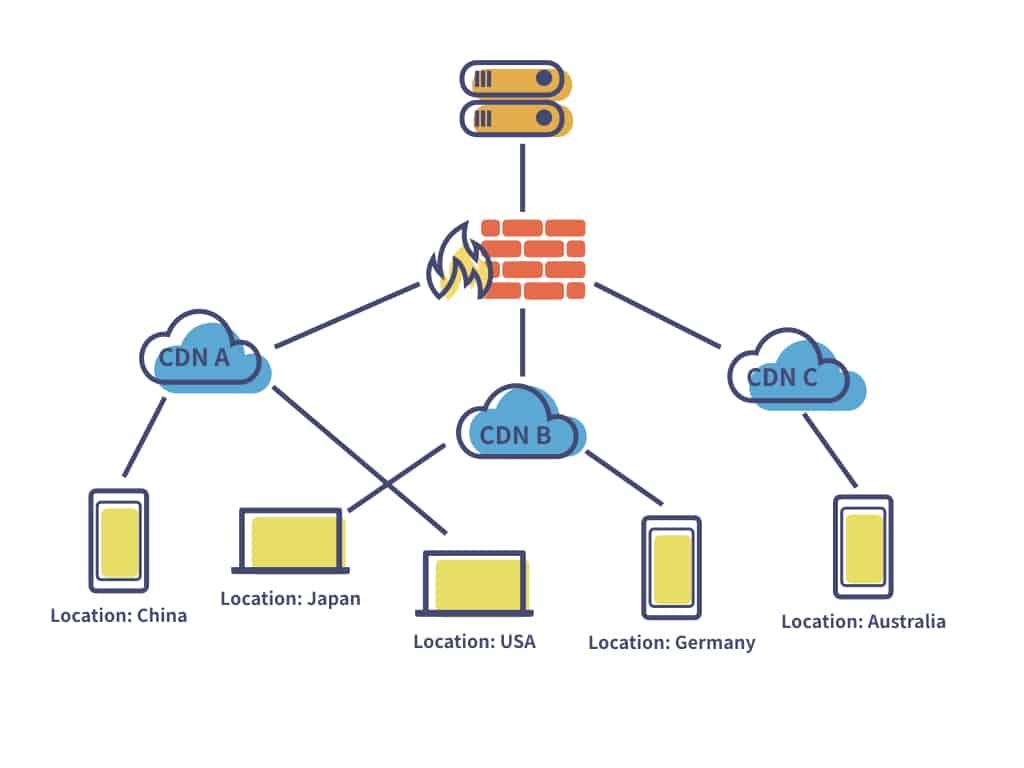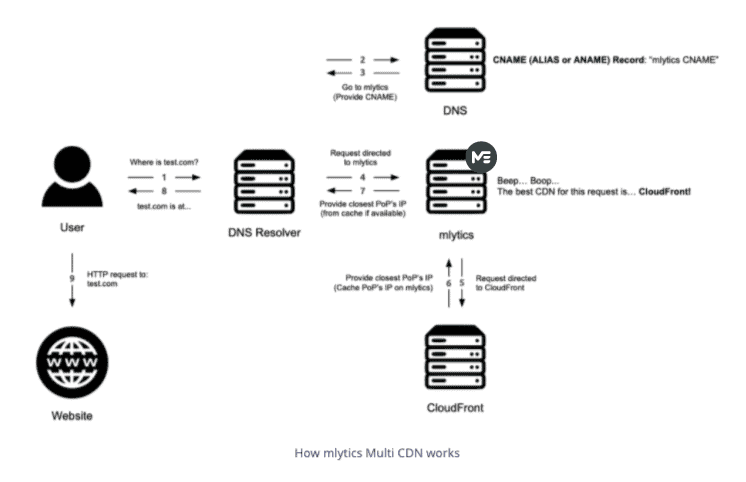With an ever-growing demand for swift online content delivery, many companies are looking into ways to optimize their site’s user experience. One of the means to this end is Multi CDN technology.
Before delving into Multi CDN, let’s take one step back and look at Content Delivery Networks or CDNs. Over the past decades, CDNs have become commonplace in the world of website management: website owners have come to rely on the increased loading speed and added security brought by the CDN’s geographically distributed group of servers. Also, CDN’s enhance streaming capabilities and help high-profile sites manage large amounts of daily traffic.
That said, CDNs are not without limitations. Indeed, usually loading times are increased when users access websites served from a nearby CDN, but those benefits do not extend to websites loaded from farther away. In an increasingly globally-connected and internationally-competitive world, a typical CDN structure can limit an organizations’ reach, and therefore its success.
Multi CDN solutions may prove helpful in mitigating the caveats inherent to single CDN solutions.
What is Multi CDN?
A Multi CDN, as the name implies, is a solution which combines multiple CDNs from different providers into a single network to increase coverage and can help achieve better website performance compared to a single CDN solution.
Different CDN vendors allow users access to different networks of edge servers or Points of Presence (PoPs), different underlying network infrastructures, and different sets of specialized features and functions. Therefore, different CDN vendors may deliver different performance, security, and cost benefits too depending on traffic, workload and geo location. Multi CDN allows organizations to use “the best CDN for the job” by directing specific traffic and workload to specific CDNs.

While Multi CDN strategy isn’t a new concept, there have been some misconceptions about deploying a Multi CDN solution, leaving some with a bit of doubt. We demystified some of the misconceptions in this article.
Why Multi CDN?
Organizations of different scales stand to gain several key benefits from investing in a Multi CDN strategy:
- Global performance enhancement – Single CDN performance can vary by region, whereas Multi CDNs, spread across several regions improves overall latency stats. Also, special regions like China and Russia present notorious challenges to website delivery, and a Multi CDN solution can help organizations work around issues related to local regulations and controls. Multi CDN allows companies to gain granular control of their content delivery, sometimes all the way down to the city level.
- Continuous website uptime – When one CDN provider experiences an outage, Multi CDN automatically routes web traffic through another provider. Web content delivered by Multi CDNs is not affected by traffic spikes or fluctuations. Over the course of 2021, plenty of outages took place, among others 2 large-scale events happened with Fastly and Akamai.
- Enhanced user experience – Modern websites must be able to not only deliver graphic-heavy content, but users expect that content to be of high quality and delivered near-instantly. This can be a challenging issue to overcome with single CDN setups. Multi CDNs can help ensure that websites can keep up with users’ demands, especially in terms of streaming content.
- Accelerated website load times – Deploying a Multi CDN setup can improve website load times by distributing content through nearby CDN servers. Faster load times can reduce bounce rates and increase the amount of time visitors spend on a website.
- Cutting costs – Organizations can save on bandwidth costs and overage fees by using a Multi CDN.
- Enhanced security – Multi CDNs can enhance security by providing features like DDoS mitigation and authentication enhancements.
- Flexibility and resilience – This is a very important factor to reduce risks for both financial and technical reasons. Instead of being locked into a single CDN provider, businesses often have more flexibility when using Multi CDN to spread risks across the board.
Multi CDN to mitigate cloud incidents
Most likely, you’ve selected a CDN that promises reliable service. In truth, even the largest, most trusted service providers can experience unexpected downtime, sometimes with devastating consequences. Lost profits due to website downtime are bad enough; the long term, negative impact of tainted customer loyalty could be even worse.
“Website operators have to take some of the blame for outages. More sites should consider using a Multi CDN strategy to reduce risk.” Michael Dorosh, Senior Director, Gartner

There’s a good chance you’ve personally been affected by a CDN outage at some point. CDN downtime has affected popular, heavily-trafficked websites like Amazon, Netflix, Facebook, and Verizon, to name just a few. If companies as prominent as these can be taken out by CDN failure, it’s easy to understand why smaller organizations are equally, if not, more vulnerable when they rely on a single CDN provider.
Most companies cannot easily absorb this kind of financial hit. Maximizing website availability is a must for any company hoping to expand or maintain market share. Websites related to financial transactions, e-commerce, and multimedia are especially vulnerable to the consequences of website downtime.
The best way to implement Multi CDN
1. DNS load balancing
There are a couple of DNS providers on the market that allow users to customize their traffic routing rules. Once they have subscribed to all the CDNs they need, they can copy the CNAMEs of all the CDNs and paste it in the DNS record so the DNS server can determine which CNAME (CDN) to use for the request based on the traffic routing rules. Here are some of the most common traffic routing rules:
- Round robin – CDNs “take turns” serving content to spread the load across activated CDNs. This method doesn’t take any factors into account, simply distributing traffic to all CDNs equally.
- Weighted round-robin – Also known as “ratio load balancing”, instead of equally distributing traffic across all CDNs, this method sets traffic ratio to weight traffic accordingly and assign priorities to specific CDNs.
- Geolocation – This method determines a user’s location and finds the closest PoP/CDN to distribute their requests (traffic).
How it works
- When a user visits www.test.com, this triggers a DNS lookup.
- The DNS provider will determine which CNAME to use based on the traffic routing rules.
- The request is now being directed to the designated CDN based on the CNAME.
- The user is now accessing www.test.com via the assigned CDN.
Pros
- The easiest option for most businesses
Cons
- Need to subscribe to CDNs individually via different platforms (more platform and contract to manage)
- Most DNS do not perform load balancing intelligently
2. RUM/synthetic monitoring-driven load balancing
Some providers including Mlytics offer this service as a package to push Multi CDN to the next level. The basic idea is to utilize the RUM and synthetic monitoring data as the foundation to drive load balancing decisions.
DNS providers that offer this service usually process this on the DNS level, meaning it’s pretty much similar to the ‘DNS load balancing’ method, except it’s making decisions intelligently based on actual performance data. Other providers including Mlytics process this on the system level taking in requests, measure, and return the best CNAME or IP (of a CDN) back to the DNS.
How it works
- When a user visits www.test.com, this triggers a DNS lookup.
- The system will measure user geolocation, network latency, and CDN performance.
- The system finds out the best CDN for the user, and route the request to the designated CDN.
- The user is now accessing www.test.com via the assigned CDN.
Pros
- Ensures the best experience for users
- Zero programmings required, everything’s off-the-shelf
Cons
- Need to subscribe to CDNs individually via different platforms (more platform and contract to manage)
3. Turnkey Multi CDN platform
Very similar to method 2 (RUM/synthetic monitoring-driven load balancing) but without the lengthy CDN subscription process. There are several providers in this field, but only Mlytics provides a Multi CDN Marketplace-like platform. The main perk of this type of solution is that it gives businesses the power to subscribe to any CDNs on demand instead of asking the providers to do so on behalf. In other words, with Mlytics you are in the driver’s seat.
How it works
- When a user visits www.test.com, this triggers a DNS lookup.
- The request is redirected to the Mlytics system via the CNAME assigned by Mlytics if it is properly pasted in the DNS record.
- The system will measure user geolocation, network latency, and CDN performance.
- The system finds out the best CDN for the user, and route the request to the designated CDN.
- The user is now accessing www.test.com via the assigned CDN.

Pros
- One platform to rule them all: subscribe to and manage multiple CDNs via one single platform
- Unified configuration and analytics for multiple CDNs
Cons
- Some lesser-known CDNs might not be immediately available
Takeaways
When looking for ways to enhance your website’s performance and security, CDN solutions go a long way. Strategically located edge servers bring content closer to the user and filter out unwanted traffic. However, in an era where you cannot afford a second of website downtime, you may want to consider a more resilient solution to mitigate the possible risks of website downtime.
One of such solutions is Multi CDN. Mlytics Multi CDN marketplace simplified the implementation process significantly by offering a centralized platform where you can subscribe to any CDN listed as you see fit. We have a system in place that can intelligently route traffic across all the CDNs activated via the platform which takes the end-user geolocation and CDN performance status into consideration when making routing decisions. Thanks to our smart load balancing technology you no longer need to worry about your website going down.



